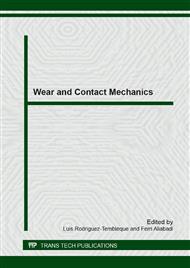[1]
M.L. Williams. The stress around a fault or crack in dissimilar media. Bull. Seismol. Soc. Am. 49 (1959) 199–204.
Google Scholar
[2]
A.H. England. A crack between dissimilar media. J. Appl. Mech. 32 (1965) 400-402.
Google Scholar
[3]
F. Erdogan. Stress distribution in bonded dissimilar materials with cracks. J. Appl. Mech. 32 (1965) 403-410.
DOI: 10.1115/1.3625814
Google Scholar
[4]
J.R. Rice, G.C. Sih. The bending of plates of dissimilar materials with cracks. J. Appl. Mech. 31 (1964) 477-483.
Google Scholar
[5]
B.M. Malyshev, R.L. Salganik. The strength of adhesive joints using the theory of fracture. Int. J. Fract. Mech. 1 (1965) 114-128.
DOI: 10.1007/bf00186749
Google Scholar
[6]
J.R. Rice. Elastic fracture mechanics concepts for interfacial cracks. J. Appl. Mech. 55 (1988) 98-103.
DOI: 10.1115/1.3173668
Google Scholar
[7]
J.W. Hutchinson, Z. Suo. Mixed mode cracking in layered materials. Adv. Appl. Mech. 29 (1992) 63–191.
Google Scholar
[8]
M. Comninou. The interface crack. J. Appl. Mech. 44 (1977) 631-636.
Google Scholar
[9]
M. Comninou, Interface crack with friction in the contact zone, J. Appl. Mech. 44 (1977) 780-781.
DOI: 10.1115/1.3424179
Google Scholar
[10]
M. Comninou, D. Schmuesser. The interface crack in a combined tension-compression and shear field. J. Appl. Mech. 46 (1979) 345-348.
DOI: 10.1115/1.3424553
Google Scholar
[11]
A.K. Gautesen. J. Dundurs. The interface crack in a tension field. J. Appl. Mech. 54 (1987) 93-98.
DOI: 10.1115/1.3173001
Google Scholar
[12]
A.K. Gautesen, J. Dundurs. The interface crack under combined loading. J. Appl. Mech. 55 (1988) 580-586.
DOI: 10.1115/1.3125833
Google Scholar
[13]
X. Deng. On stationary and moving interface cracks with frictionless contact in anisotropic biomaterials. Proceedings R. Soc. Lond. A, 443 (1993) 563–572.
DOI: 10.1098/rspa.1993.0162
Google Scholar
[14]
X. Deng. An asymptotic analysis of stationary and moving cracks with frictional contact along bimaterial interfaces and in homogeneous solids, Int. J. Solids Struct. 31 (1994) 2407–2429.
DOI: 10.1016/0020-7683(94)90160-0
Google Scholar
[15]
J. Lee, and H. Gao, A generalized Comninou contact model for interface cracks in anisotropic elastic solids. Int. J. Fracture 67 (1994) 53-68.
DOI: 10.1007/bf00032364
Google Scholar
[16]
B. Audoly. Asymptotic study of the interfacial crack with friction. J. Mech. Phys. Solids. 48 (2000) 1851-1864.
Google Scholar
[17]
H.D. Bui, A. Oueslati. The sliding interface crack with friction between elastic and rigid bodies, J. Mech. Phys. Solids 53 (2005) 1397–1421.
DOI: 10.1016/j.jmps.2004.12.007
Google Scholar
[18]
D.A. Hills, P.A. Kelly, D.N. Dai, A.M. Korsunsky, Solutions of Crack Problems. The Distributed Dislocation Technique, Kluwer Academic Publishers, Dordrecht, 1996.
Google Scholar
[19]
V. Mantič, A. Blázquez, E. Correa, F. París. Analysis of interface cracks with contact in composites by 2D BEM. In: Fracture and Damage of Composites, M. Guagliano, M.H. Aliabadi (Eds.), Wessex Institute of Technology Press, 2006, pp.189-248.
DOI: 10.2495/978-1-85312-669-7/08
Google Scholar
[20]
D.A. Hills, J.R. Barber. Interface cracks. Int. J. Mech. Sci. 35 (1993) 27-37.
Google Scholar
[21]
C. Atkinson. The interface crack with a contact zone (an analytical treatment). Int. J. Fracture 18 (1982) 161-177.
DOI: 10.1007/bf00032272
Google Scholar
[22]
E. Graciani, V. Mantič, F. París. On the estimation of the first interpenetration point in the open model of interface cracks. Int. J. Fracture 143 (2007) 287-90.
DOI: 10.1007/s10704-007-9066-5
Google Scholar
[23]
E. Graciani, V. Mantič, F. París. Critical study of existing solutions for a penny-shaped interface crack, comparing with a new boundary element solution allowing for frictionless contact. Eng. Fract. Mech. 76 (2009) 533-47.
DOI: 10.1016/j.engfracmech.2008.11.007
Google Scholar
[24]
E. Graciani, V. Mantič, F. París. A BEM analysis of a penny-shaped interface crack using the open and the frictionless contact models: Range of validity of various asymptotic solutions. Eng. Anal. Boun. Elem. 34 (2010) 66-78.
DOI: 10.1016/j.enganabound.2009.06.006
Google Scholar
[25]
A.R. Zak. Stresses in the vicinity of boundary discontinuities in bodies of revolution. J. Appl. Mech. 31 (1964) 150-152.
DOI: 10.1115/1.3629542
Google Scholar
[26]
J. Dundurs. Discussion on a paper by Bogy DB. J. Appl. Mech. 36 (1969) 650-652.
Google Scholar
[27]
M.K. Kassir, A.M. Bregman. The stress-intensity factor for a penny-shaped crack between two dissimilar materials. J. Appl. Mech. 39(1972) 308-10.
DOI: 10.1115/1.3422648
Google Scholar
[28]
E. Graciani, V. Mantič, F. París, A. Blázquez. Weak formulation of axi-symmetric frictionless contact problems with Boundary Elements. Application to interface cracks. Comput. Struc. 83 (2005) 836-855.
DOI: 10.1016/j.compstruc.2004.09.011
Google Scholar
[29]
A. Blázquez, F. París, V. Mantič. BEM solution of two dimensional contact problems by weak application of contact conditions with non-conforming discretizations. Int. J. Solids. Struct. 35 (1998) 3259-78.
DOI: 10.1016/s0020-7683(98)00016-x
Google Scholar
[30]
F.París, J. Cañas. Boundary element method: fundamentals and applications, Oxford University Press, Oxford, 1997.
Google Scholar
[31]
Y. Ju Ahn, J.R. Barber. Response of frictional receding contact problems to cyclic loading, Int. J. Mech. Sci. 50 (2008) 1519-1525.
DOI: 10.1016/j.ijmecsci.2008.08.003
Google Scholar


